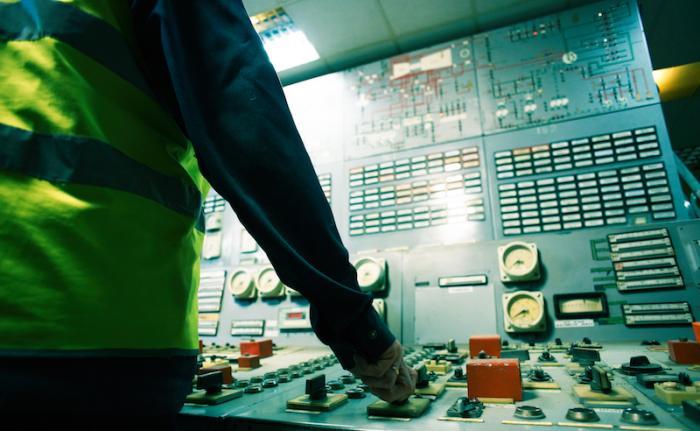SCADA System: What is it and How it Works
When we think about technologies which have revolutionized industrial automation, we often think about a specific piece of hardware we interact with, rather than the software behind the scenes. For factories and manufacturing plants, the Programmable Logic Controller (PLC) dramatically improves efficiency and control; yet it’s the SCADA software which runs all the operations smoothly.
In order to understand the basics of SCADA systems, it’s important to know what they are, their functions and components, and their place in modern industrial workplaces.
What Is a SCADA System?
If you’ve worked in a factory, chances are you’ve heard the term SCADA. However, if you’re not familiar with factory floors, this might be a forgien concept. SCADA systems are an industrial control system at the core of many manufacturing plants’ daily operations. SCADA stands for Supervisory Control and Data Acquisition. Simply put, SCADA systems gather and quickly analyze real-time data. In the manufacturing sector, they’re used to monitor and automate the control processes of industrial automation.
The basic SCADA architecture begins with PLCs or Remote Terminal Units (RTUs). These microcomputers receive data from the sensors and machinery within a factory or operation, then route the information to computers running the SCADA software. The software processes, distributes, and displays information on a Human Machine Interface (HMI) for a human operator to make decisions based on the information.
SCADA systems were first introduced to the factory floor after the implementation of industrial computers; primarily PLCs. The term “SCADA system” was coined in the early 1970s, as the software which allowed automated communications to transmit data from remote sites to monitoring equipment. Some of the biggest industries that use SCADA include oil and gas, food and beverage, automotive, and chemicals. A basic SCADA system has several key components and functions, which is what we’ll explore below.

Functions of a SCADA System
The software and hardware elements of a SCADA system work together in order to perform the functions which collect, analyze and display real-time data from factory operations. Modern SCADA systems offer the ability to monitor and control various processes from a remote location.
A SCADA system has four primary functions: data acquisition, network data communication, data presentation, and control.
Data Acquisition
SCADA systems acquire data from sensors and network devices connected to PLCs. They measure parameters such as speed, temperature, weight, flow rate, gaseous emissions and pressure. This raw data is then sent to a PLC to process, and then on to an HMI for a human operator to analyze and make decisions as required.
Network Data Communication
The use of wired or wireless communications technologies is important for SCADA systems when transmitting data between machines and operators. These networks allow multiple systems to be controlled from a central location.
Data Presentation
SCADA systems report data to either an HMI or a HCI (Human Computer Interface), where the information is displayed to a human operator. This master station continuously monitors all sensors and alerts the operator when there is an “alarm” or dysfunction - when a control factor is not functioning within normal operational range.
Control
SCADA systems can be programmed to perform certain control decisions based on data collected from the sensors. Control functions may include turning power on/off, adjusting temperature, decreasing or increasing speed, and regulating a variety of industrial processes.
Components of a SCADA System
SCADA systems are composed of numerous hardware and software mechanisms working together to perform the functions listed above. The hardware consists of data collection devices such as sensors, relays and switches. SCADA software analyzes and translates the data which is then sent to the operators, and also has the ability to be programmed for control and alarm functions.
Digital or analog inputs and sensors are responsible for measuring and controlling the status and parameters of a machine. Their primary function is data acquisition, which is then sent to the PLCs or RTUs. PLCs and RTUs are small industrial computers which collect data from the inputs and sensors and report the information in a meaningful way. They serve as local collection points for gathering reports and also deliver commands to control relays. Data collected from multiple PLCs is subsequently sent to a central HMI.
HMIs serve as the master and satellite computer stations which allow a human operator to analyze all the collected data from networked devices and sensors. The information is often displayed in graphical pictures and maps representing machines and devices, data charts, and performance reports. Based on the information, the human operator can make informed decisions to optimize the efficiency of the production process. The communications network is what allows data to be sent between the machines, PLCs, and operators. SCADA systems typically use a closed LAN for local geographical areas, or WANs to connect to different regions. Without a correctly designed communication network, a SCADA system would not be able to function.
SCADA Systems In Modern Industrial Automation
In modern industrial workplaces, PLCs are widely used as the device which communicates data from sensors and inputs to an HMI, in order for operators to make decisions about the manufacturing processes. However, it’s the SCADA software which works between all the components to keep operations running efficiently.
When learning the fundamentals of PLCs, it's important to know the basics of the software and the components and functions of a SCADA system. For hands-on learning, check out the PLC Technician Program.
Comments
Plc and scada training
Submitted by INDRAJEET MOHATY (not verified) on Wed, 04/05/2023 - 13:27
How can I get this training
You can register for the PLC…
Submitted by iris on Thu, 04/06/2023 - 08:13
You can register for the PLC Technician II program at https://www.plctechnician.com/how-to-register. Please contact a Program Consultant, toll-free at 1-888-553-5333, should you require further assistance.
Plc and scada
Submitted by Azmi Hasan (not verified) on Wed, 11/22/2023 - 21:48
How I training this classes let me know
The programs have open…
Submitted by iris on Thu, 11/23/2023 - 07:23
The programs have open enrollment, with no predetermined time limits. That means you can start at your convenience and finish at your own pace. We use state-of-the-art simulator, PLCLogix 500 and PLCLogix 5000, which acts as a real world tool. With the simulator you can design, test and troubleshoot PLC ladder logic circuits.
For further assistance contact a Program Consultant toll-free at 1-888-553-5333.

Excellent